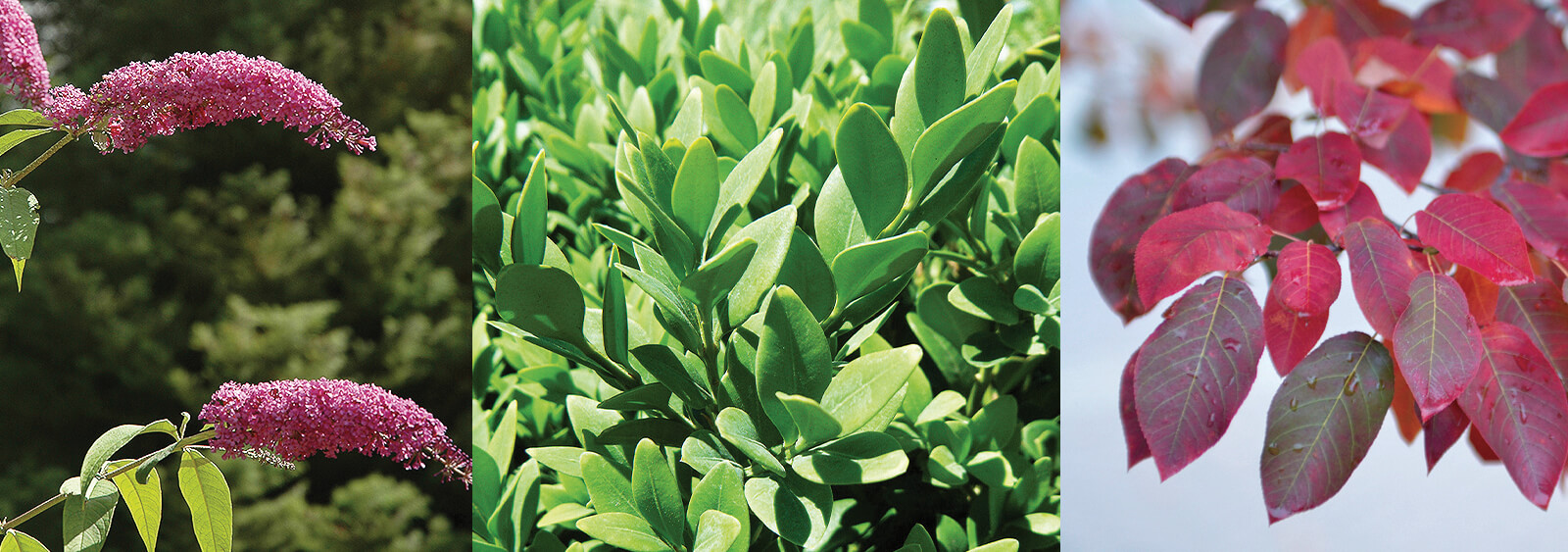April 15, 2016

Buddleja, boxwood and serviceberry.
Ontario woody plants: A designers and growers initiative
By Christopher Clayton OALA, CLD
This initiative began one dark and stormy winter’s night last November. Fellow landscape designer Chris Mace and I were asked to talk at the annual growers’ dinner about what plants to grow for our designs. A lively conversation ensued. As the growers began to tell us the problems they had and what we as designers should be aware of, I realized that a collection of information useful to designers and growers on all woody plants grown in Ontario would benefit all of us. After subsequent conversations with growers, I organized the information into a framework of five categories: Commercial and Industrial, Municipal, Residential, Restoration and Naturalizing, and Highways.
Each month, we are asking LO members to comment on a short list of woody plants as follows:
No detailed descriptions of height, colour, flowering time, etc. are necessary. We will collect and edit these comments into a searchable database for LO members and the industry. For example:
This month, we need your input on the first group of woody plants:
Abies balsamea/balsam fir
Abies concolor/white fir
Abies koreana/Korean fir
Aesculus/chestnut
Amelanchier/serviceberry
Betula nigra/river birch
Betula papyrifera/paper birch
Azalea/azalea
Buxus/boxwood
Buddleja/butterfly bush
Ceanothus/New Jersey tea
The full plant list is available online. To see the list or provide your input, visit horttrades.com/ontario-woody-plants.
This initiative began one dark and stormy winter’s night last November. Fellow landscape designer Chris Mace and I were asked to talk at the annual growers’ dinner about what plants to grow for our designs. A lively conversation ensued. As the growers began to tell us the problems they had and what we as designers should be aware of, I realized that a collection of information useful to designers and growers on all woody plants grown in Ontario would benefit all of us. After subsequent conversations with growers, I organized the information into a framework of five categories: Commercial and Industrial, Municipal, Residential, Restoration and Naturalizing, and Highways.
Each month, we are asking LO members to comment on a short list of woody plants as follows:
- Their suitability for each of the five categories
- The need for more of these plants (or the reasons why there is a need for less of them)
- Any problems with them (diseases, growing restrictions)
- Underuse or overuse of them in designs
- Successful alternatives
- Desirable characteristics
No detailed descriptions of height, colour, flowering time, etc. are necessary. We will collect and edit these comments into a searchable database for LO members and the industry. For example:
- Gymnocladus/Kentucky coffee tree is a native tree that should do well in the future. However, it’s an ESA tree, which means you have to stay away 25 metres from it, so be aware you should include instructions on where to plant it when you specify it.
- Picea/blue spruce is over-planted. Suggested alternatives are Serbian spruce and balsam fir.
Your input is needed
The success of this initiative requires feedback from you. Each month, we ask you to visit horttrades.com/ontario-woody-plants to provide feedback on the plants listed at the end of this article. At that link you will find the complete plant list, with each plant linked to a short online feedback form (see bullet points earlier in this article). As the list grows each month, more feedback forms will be active online.This month, we need your input on the first group of woody plants:
Abies balsamea/balsam fir
Abies concolor/white fir
Abies koreana/Korean fir
Aesculus/chestnut
Amelanchier/serviceberry
Betula nigra/river birch
Betula papyrifera/paper birch
Azalea/azalea
Buxus/boxwood
Buddleja/butterfly bush
Ceanothus/New Jersey tea
The full plant list is available online. To see the list or provide your input, visit horttrades.com/ontario-woody-plants.